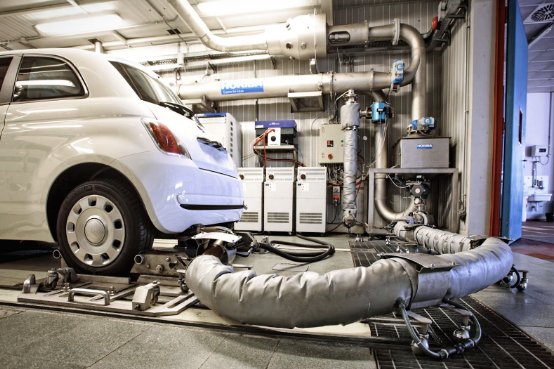When your car fails an emissions test, it can feel like a significant hurdle, especially when you rely on your vehicle for daily transportation. This failure not only indicates potential environmental harm but also pauses the ability to drive your car until the issues are resolved legally. Understanding the emissions test, why cars fail, and the steps to take afterward can alleviate some of the stress associated with this process.
Emissions Tests
Purpose and Importance
Emissions tests are a critical component of efforts to reduce air pollution and protect the environment. These tests help minimize releasing harmful pollutants and greenhouse gasses into the atmosphere by ensuring that vehicles meet specific emission standards. Modern vehicles’ on-board diagnostics (OBD) system plays a key role in these tests by monitoring the performance of various systems that affect emissions.
The Testing Process
An emissions test typically involves connecting the testing equipment to your car’s Data Link Connector (DLC) or OBD2 port. This allows the inspector to access data stored in the vehicle’s OBD system, including any diagnostic trouble codes (DTCs) that system failures or malfunctions may have triggered.
Common Causes of Failure
Technical Issues
Disconnected Car Battery: Resetting the OBD system’s memory, which can happen with a recent battery disconnection, leaves the vehicle unprepared for an emissions test.
DLC Issues: Problems with the OBD2 port can prevent the test equipment from properly connecting to the vehicle’s diagnostics system.
“Check Engine Light” Triggers: This light can indicate various issues, from exhaust system problems to faults in the battery or alarm systems.
Mechanical Failures
Exhaust System Issues: The catalytic converter, a critical component of the exhaust system, helps convert harmful gases into less harmful emissions. Failures here can directly lead to an emissions test failure.
Systemic Failures: Faults in the ignition, fuel injection, and air injection systems can all contribute to increased emissions.
Faulty Sensors: Oxygen and mass airflow sensors regulate the fuel-air mixture. When these sensors fail, emissions can spike.
Miscellaneous Causes: Something as simple as a loose gas cap or overdue oil change can cause a vehicle to fail its emissions test.
Immediate Steps After Failing an Emissions Test
Upon failing an emissions test, your immediate action should be to review the vehicle inspection report. This document will list DTCs and pinpoint the systems or components needing attention. Consulting with a qualified mechanic is crucial to determine the necessary repairs or services to bring your vehicle into compliance.
Retesting and Grace Periods
After addressing the issues, a retest is in order. Many jurisdictions offer a grace period during which you can drive your vehicle legally while making the necessary repairs. This grace period varies, so checking with your local DMV or equivalent authority for specific details is important.
Dealing with Repeated Failures
When a vehicle fails emissions tests repeatedly, it indicates persistent issues that require detailed attention and possibly more sophisticated solutions. Here’s how to approach this situation:
- Comprehensive Diagnostic Evaluation: After multiple failures, a comprehensive diagnostic check is paramount. This should be more thorough than the initial assessments and may involve advanced diagnostic technology. Look for a mechanic or a service center that specializes in emissions problems. They can offer a deeper insight into underlying issues that standard diagnostics may miss.
- Seeking Specialist Help: If general repairs have not fixed the issue, it may be time to consult with a specialist. Certain vehicles, especially older models or those with higher mileage, may have specific vulnerabilities that generic repair shops are not equipped to handle. Specialists in your vehicle’s make or in emissions systems can provide targeted solutions.
- Preventative Measures for the Future: Once your vehicle passes, maintaining it to prevent future emissions failures is crucial. Regular maintenance, immediate attention to any dashboard warning lights, and pre-test checks can help avoid repeat issues. Educate yourself on your vehicle’s common problems and stay proactive in its care.
Remember, repeated emissions test failures can be frustrating, but they often signal deeper mechanical issues that, once resolved, can extend the life of your vehicle and improve its performance and environmental impact.
General Repair Cost Limits
Some states and localities offer waivers if you’ve spent a significant amount on repairs in an attempt to pass the emissions test but are still facing issues. These waivers acknowledge the effort and expense already invested and provide relief, though they often come with stipulations regarding future compliance efforts.
Preventive Measures and Maintenance
Preventive maintenance is key to avoiding emissions test failures. Regular check-ups, timely oil changes, and keeping an eye on the check engine light can all help maintain your vehicle’s systems in optimal condition. Additionally, addressing any issues as soon as they arise, rather than waiting for the emissions test, can save time, money, and stress.
Conclusion
Failing an emissions test is not the end of the road but rather a call to action for vehicle maintenance and environmental responsibility. By understanding the common causes of failure and the steps to take afterward, you can navigate the process more smoothly. Remember, the goal of emissions testing is not just regulatory compliance but also contributing to cleaner air and a healthier environment. Proactive vehicle maintenance and awareness of local emissions testing requirements are your best tools for success.
FAQs
What should I do if my car fails an emissions test right before my registration expires?
If your car fails an emissions test close to your registration’s expiration date, contact your local DMV or equivalent authority immediately. Explain the situation and ask about temporary permits or extensions that may allow you to use your vehicle while you address the emissions issues.
Can I sell a car that has failed an emissions test?
Yes, you can sell a car that has failed an emissions test, but you must disclose this information to the buyer. The new owner will be responsible for making the necessary repairs to pass the emissions test and legally register the vehicle.
If I receive a waiver for emissions failure, does it affect my insurance rates?
Receiving a waiver for an emissions test failure typically does not directly affect your insurance rates. However, if the underlying issue causing the emissions failure leads to a larger mechanical problem or accident, it could impact your insurance.
Get the right coverage for your car with tutenagency
New tutenagency customers?
Quote auto insurance online or call (334) 502-5111 to insure your vehicle.
Disclaimer: This content is for informational purposes only and should not be considered legal or financial advice. Always consult with qualified professionals in legal and financial fields before making any decisions.

